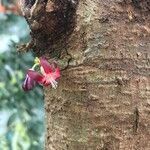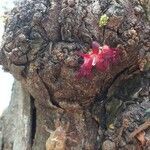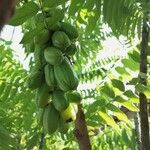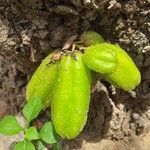Shrub or tree, up to 15 m, 30 cm ø. Branches erect. Innovations and green parts long-persisting pale yellowish to rusty velvety. Leaves 7-19-jugate, usually terminally tufted; rachis 17-57 cm; leaflets up to 12 by 4 cm, variable in pubescence, size and shape, lower reflexed, acute to acuminate, not glaucous beneath; nerves 6-14 pairs. Panicles cauliflorous on tubercles, nearly down to ground-level, fasciculate and pendulous up to 20 cm, rarely axillary, solitary and erect. Flowers heterotristylous, usually MF. Pedicels 4-17 mm, articulated near or below the middle. Sepals 3-8 by 1½-3 mm, yellowish red to purplish, sparsely appressed-puberulous outside mainly at base, inside glabrous or subglabrous, elliptic to lanceolate or spathulate, acute to rounded. Petals free, 10-20 by 3-4 mm, lanceolate-spathulate, inside glabrous, claw 3-6 mm. Stamens all fertile, in SF 3½-4 and 7 mm, in MF 2-5 and 9-12 mm, in LF 5 and 7½ mm, bases not thickened. Ovary densely appressed pale strigose and with short, septate-glandular hairs, in SF 2-2½ by 1 mm, in MF 3-4 by 1-1½ mm, in LF 4 by 1 mm, elliptic; styles in SF ½-¾ mm, in MF 2-4 mm, in LF 6½-9 mm; ovules 4-7 per cell. Fruit terete-obtusangular, up to 10 by 5 cm, elliptic to obovate, obtuse, rimae present (?), base tapering. Seeds up to 14, 6-7 by 4-6 mm, exarillate; cotyledons 4-6 by 3½-5 mm, orbicular, cordate.
A small evergreen tree up to 7-10 m high. It can spread 3 m across. The stem is erect and short. Leaves are large. Leaves have from 5 to 17 or 34 pairs of leaflets. Leaves are pale green. The leaves are often clustered near the branch tips. Flowers are crimson. They are produced on old branches and the stem. The flowers are in 15 cm long clusters. These then bear clusters of cucumber shaped fruit on the trunk and older branches. Fruit are 8-10 cm long and yellow or green. They are soft and fleshy with a few flat seeds in the centre. Fruit are sour but edible.
Plants 5-6(-15) m tall, young parts and petioles rusty pubescent. Leaves 15-40 cm, aggregated at apex of branches; petiole 2-4 mm; leaflets 10-20 pairs; leaflet blades oblong to lanceolate, 3-5 × ca. 2 cm, both surfaces somewhat pubescent, base obliquely rounded, apex acuminate. Inflorescences rameal, paniculate, many flowered. Sepals ovate-lanceolate, ca. 4 mm, pubescent. Petals reddish purple, 13-18 × ca. 3 mm. Stamens all fertile. Berry greenish yellow, oblong, 5-10 cm, terete to obscurely 5-angled, fleshy. Seeds few, flat. Fl. Apr-Dec, fr. Jul-Dec.
The Blimbing, is occasionally cultivated for its fruits.
Fruits obtusely angled
10–20 or more leaflets
Flowers on older wood





